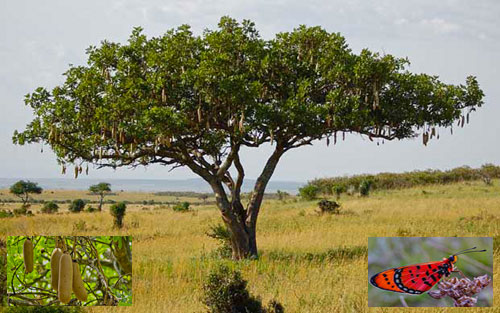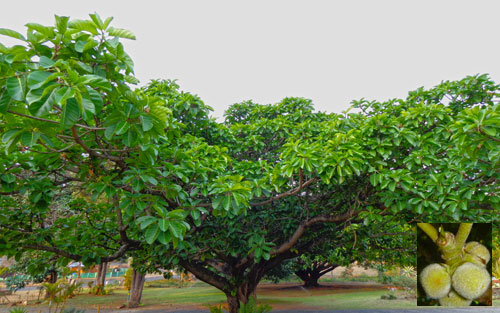Trees

Coral Tree. Erythrina lysistemon.
Family: Fabaceae/Leguminosae (Pea & bean family). Subfamily: Papilionoideae.
Common names: common coral tree, lucky bean tree (E), gewone koraalboom, kanniedood (A), umsintsi (X), muvhale (V), mophete (Tsw), mokhungwane (Sotho), umsinsi (Z).
Erythrina lysistemon is a lovely, small to medium-sized, deciduous tree with a spreading crown and brilliant red flowers. It is a handsome tree at any time of the year, and its dazzling flowers have made it one of the best known and widely grown South African trees.
This is a stocky, thickset tree that often branches low down and usually grows up to 10 m in height, occasionally reaching 12 m. The bark is smooth and dark gray to gray-brown and is not thickly corky. Short, hooked prickles are sparsely and randomly scattered on the trunk and branches. The leaves are trifoliolate (compound leaves with 3 leaflets), and each leaflet is large, usually up to 17 x 18 cm. The petiole, rachis and the midrib have hooked prickles on them. The common coral tree blooms in early spring (from August to September) and it produces its flowers before its new leaves or just as the leaves begin to show.
The flowers are a beautiful clear scarlet and are carried in short, dense heads, about 9 cm long, on long, thick stalks. The standard petal (the large uppermost petal) is long and narrow and encloses the other petals and the stamens. The flowers produce abundant nectar that attracts many nectar-feeding birds and insects, which attract the insect-feeding birds as well.
The fruit is a slender, black pod that can be 15 cm long and is sharply constricted between the seeds. The pod splits while still attached to the tree to release bright red 'lucky bean' seeds.
It occurs in a wide range of altitudes and habitats from North West Province, Limpopo (formerly Northern Province), Gauteng, Mpumalanga, through to Swaziland and KwaZulu-Natal, and down to about the Mbashe River Mouth in Eastern Cape. Further north in Zimbabwe, Botswana and Angola it occurs in small pockets. It grows in scrub forest, wooded kloofs, dry woodlands, dry savannah, koppie slopes and coastal dune bush and also in high rainfall areas.
It is not just a decorative tree, it is also an important component of the ecosystem, providing food and shelter for a variety of birds, animals and insects. Many birds and insects feed on the nectar. Vervet monkeys eat the flower buds. Kudu, klipspringer, black rhino and baboons graze on the leaves. Black rhinos, elephants and baboons eat the bark. Bush pigs eat the roots, and the brown-headed parrot eats and disperses the seed. Birds such as barbets and woodpeckers nest in the trunks of dead trees, and swarms of bees often inhabit hollow trunks.
It is also widely used and enjoyed by mankind. They have been regarded as royal trees, and were planted on the graves of Zulu chiefs. They were planted as living fences around kraals, homesteads and waterholes, and were one of the first wild trees to be planted in gardens in South Africa. They are still to be found in many gardens, and are planted as street trees in many towns. The wood is light and cork-like when dry and has been used for making canoes, rafts and floats for fishing nets as well as for troughs and brake-blocks. It has also been used to make shingles for roofing, as the wood is durable when tarred. The flowering of the trees has been, and still is, a good signal to the people that it is time to plant their crops.
It is thought to have both medicinal and magical properties by many people. A tribal chief will wash in water in which bark has been soaked as he believes that by doing this he will ensure the respect of his people. Women about to give birth are given an infusion of herbs to make the birth easier and a sliver of bark from the four sides of the tree is tied around the bundle of herbs before it is boiled. Water in which bark has been soaked is mixed with the root of a species of Cussonia and used as a purifying emetic. Crushed leaves placed on a maggot-infested wound are said to clear the maggots. The bark applied as a poultice is used to treat sores, wounds, abscesses and arthritis. Infusions of the leaves are used as ear drops to relieve earache, and decoctions of the roots are applied to sprains. It does contain a large number of alkaloids that are known to be highly toxic, but its use in traditional medicine suggests that they have antibacterial, anti-inflammatory and analgesic effects. The seeds are used as lucky charms. The seeds also contain toxic alkaloids as well as anti-blood-clotting substances that may be of value in the treatment of thromboses.

Sausage Tree. Kigelia africana.
Family: Bignoniaceae
Common names: sausage tree (Eng.); worsboom (Afr.); umVunguta, umFongothi (Zulu); Modukguhlu (North Sotho); Muvevha (Venda).
The sausage tree boasts long, open sprays of large, wrinkled, maroon or dark red trumpet-shaped flowers that are velvety on the inside and that virtually overflow with nectar. The unique fruits look like giant sausages! The short, squat trunk has light brown, sometimes flaky bark and supports a dense rounded to spreading crown (18 m high, 20 m wide) of leathery, slightly glossy foliage (deciduous). The huge, grey-brown fruits, 800 x 120 mm. hang from long stalks, from December (summer) to June (winter) and weigh anything up to 9 kg!
The tree is found on riverbanks, where it may reach 20 m, along streams and on floodplains, also in open woodland, from KwaZulu-Natal to Tanzania.
It is one of the first trees to flower in Mpumalanga in early spring (August to October). After prolonged, dry winters, the trees are still 'alive' with insects and birds. Black Scarletchested and Whitebellied Sunbirds, Blackheaded Oriole, Sombre and Blackeyed Bulbuls, Masked Weaver, Brownheaded Parrot and Grey Lourie (which eats the flowerbuds). Duiker, kudu and impala eat the fallen flowers. Elephant and kudu occasionally browse the leaves, and baboons, monkeys, bushpigs and porcupines eat the fruit. Epauletted fruit bats are thought to pollinate the flowers and Charaxes butterflies also visit the tree.
In Malawi, roasted fruits are used to flavour beer and aid fermentation. The tough wood is used for shelving and fruit boxes, and dugout canoes are made from the tree in Botswana and Zimbabwe. Roots are said to yield a bright yellow dye. Traditional remedies prepared from crushed, dried or fresh fruits are used to deal with ulcers, sores and syphilis - the fruit has antibacterial activity. Today, beauty products and skin ointments are prepared from fruit extracts. Fresh fruit cannot be eaten - it is said to be a strong purgative, and causes blisters in the mouth and on the skin. Green fruits are said to be poisonous. In time of scarcity, seeds are roasted and eaten.

Wild Fig Tree. Ficus lutea.
Family: Moraceae. Common names: giant-leaved fig (Eng.); reuseblaarvy (Afr.); umvubu, omkhulu (Zulu); umthombe, uluzi (Xhosa).
The giant-leaved fig is a magnificent member of the renowned fig family. Like so many of its close relatives, it offers much of ecological and ornamental value. To behold a mature specimen displaying its full spread and large, sculptured buttress roots is an impressive sight and one not easily forgotten.
Ficus lutea is a large, briefly-deciduous tree, capable of growing to 25 m in height. Its large, spreading crown can span 30 to 45 m in width. This spreading habit coupled with an often short and buttressed trunk can help in revealing the tree's identity from a distance. Under forest conditions, however, it tends towards a taller growth habit with a somewhat narrower spread. The species also has the ability to become a strangler and is often encountered assuming this habit.
The giant-leaved fig is a widely distributed species. It occurs naturally in South Africa, Mozambique and Zimbabwe, into tropical and west Africa, as well as in Madagascar, the Comores and Seychelles. It is a commonly cultivated species and has become naturalized in areas previously outside its distribution range.
>> Wild Fig Tree Continued: The habitats in which it occurs are varied, ranging from coastal and riverine forest to evergreen forest and woodland. The species is seen to occur from sea level to 1 000 m and, in some areas up to 1 800 m above sea level, representing a notable altitudinal range. It tends to thrive in the warm, moist and frost-free areas within its range, and under such conditions can be a very fast grower indeed.
From an ecological perspective, the giant-leaved fig is both fascinating and remarkable. Fig trees in general have a well-founded reputation for being virtual wildlife magnets and this species proudly upholds this reputation. A wide variety of frugivorous (fruit-eating) birds are attracted by the promise of a good meal in the form of the abundant fleshy figs produced by the tree. Numerous insectivorous bird species join the feast, feeding on the rich insect life that is drawn to the figs. In addition, the figs are relished by a range of mammals that include bats, duikers and Vervet and Samango monkeys, as well as baboons in areas where they coexist with F. lutea. The masses of fallen figs also support much decomposition-related activity. The seed of the tree is effectively dispersed by many of these animals. Seed may be carried considerable distances by birds, often being deposited in the forks of trees and in the cracks of buildings and the like and here the hemi-epiphytic (and often 'strangling') nature of this species is evident.
